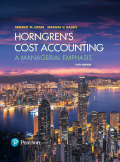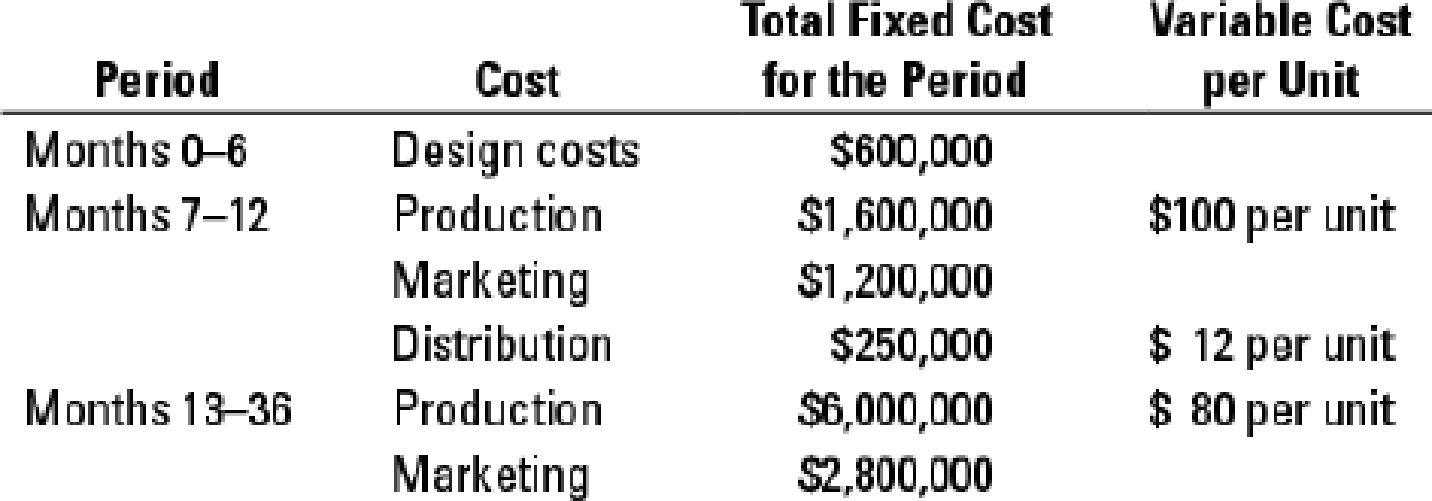
EBK HORNGREN'S COST ACCOUNTING
16th Edition
ISBN: 9780134475950
Author: Datar
Publisher: PEARSON CO
expand_more
expand_more
format_list_bulleted
Concept explainers
Textbook Question
Chapter 13, Problem 13.24E
Life-cycle budgeting and costing. Arnold Manufacturing, Inc., plans to develop a new industrial-powered vacuum cleaner for household use that runs exclusively on rechargeable batteries. The product will take 6 months to design and test. The company expects the vacuum sweeper to sell 12,000 units during the first 6 months of sales; 24,000 units per year over the following 2 years; and 10,000 units over the final 6 months of the product’s life cycle. The company expects the following costs:


Ignore the time value of money.
- 1. If Arnold prices the sweepers at $400 each, how much operating income will the company make over the product’s life cycle? What is the operating income per unit? Required
- 2. Excluding the initial product design costs, what is the operating income in each of the three sales phases of the product’s life cycle, assuming the price stays at $400?
- 3. How would you explain the change in budgeted operating income over the product’s life cycle? What other factors does the company need to consider before developing the new vacuum sweeper?
- 4. Arnold is concerned about the operating income it will report in the first sales phase. It is considering pricing the vacuum sweeper at $450 for the first 6 months and decreasing the price to $400 thereafter. With this pricing strategy, Arnold expects to sell 10,000 units instead of 12,000 units in the first 6 months, and the same number of units for the remaining life cycle. Assuming the same cost structure given in the problem, which pricing strategy would you recommend? Explain.
Expert Solution & Answer
Want to see the full answer?
Check out a sample textbook solution
Students have asked these similar questions
general account
General Accounting
Please need answer the financial accounting question
Chapter 13 Solutions
EBK HORNGREN'S COST ACCOUNTING
Ch. 13 - What are the three major influences on pricing...Ch. 13 - Relevant costs for pricing decisions are full...Ch. 13 - Describe four purposes of cost allocation.Ch. 13 - How is activity-based costing useful for pricing...Ch. 13 - Describe two alternative approaches to long-run...Ch. 13 - What is a target cost per unit?Ch. 13 - Describe value engineering and its role in target...Ch. 13 - Give two examples of a value-added cost and two...Ch. 13 - It is not important for a company to distinguish...Ch. 13 - Prob. 13.10Q
Ch. 13 - Describe three alternative cost-plus pricing...Ch. 13 - Give two examples in which the difference in the...Ch. 13 - What is life-cycle budgeting?Ch. 13 - What are three benefits of using a product...Ch. 13 - Prob. 13.15QCh. 13 - Which of the following statements regarding price...Ch. 13 - Value-added, non-value-added costs. The Magill...Ch. 13 - Target operating income, value-added costs,...Ch. 13 - Target prices, target costs, activity-based...Ch. 13 - Target costs, effect of product-design changes on...Ch. 13 - Target costs, effect of process-design changes on...Ch. 13 - Cost-plus target return on investment pricing....Ch. 13 - Cost-plus, target pricing, working backward....Ch. 13 - Life-cycle budgeting and costing. Arnold...Ch. 13 - Considerations other than cost in pricing...Ch. 13 - Cost-plus, target pricing, working backward. The...Ch. 13 - Value engineering, target pricing, and target...Ch. 13 - Target service costs, value engineering,...Ch. 13 - Cost-plus, target return on investment pricing....Ch. 13 - Cost-plus, time and materials, ethics. C S...Ch. 13 - Cost-plus and market-based pricing. Georgia Temps,...Ch. 13 - Cost-plus and market-based pricing. (CMA, adapted)...Ch. 13 - Life-cycle costing. Maximum Metal Recycling and...Ch. 13 - Airline pricing, considerations other than cost in...Ch. 13 - Prob. 13.35PCh. 13 - Ethics and pricing. Instyle Interior Designs has...Ch. 13 - Value engineering, target pricing, and locked-in...
Knowledge Booster
Learn more about
Need a deep-dive on the concept behind this application? Look no further. Learn more about this topic, accounting and related others by exploring similar questions and additional content below.Similar questions
arrow_back_ios
SEE MORE QUESTIONS
arrow_forward_ios
Recommended textbooks for you
 Managerial AccountingAccountingISBN:9781337912020Author:Carl Warren, Ph.d. Cma William B. TaylerPublisher:South-Western College Pub
Managerial AccountingAccountingISBN:9781337912020Author:Carl Warren, Ph.d. Cma William B. TaylerPublisher:South-Western College Pub

Managerial Accounting
Accounting
ISBN:9781337912020
Author:Carl Warren, Ph.d. Cma William B. Tayler
Publisher:South-Western College Pub
Responsibility Accounting| Responsibility Centers and Segments| US CMA Part 1| US CMA course; Master Budget and Responsibility Accounting-Intro to Managerial Accounting- Su. 2013-Prof. Gershberg; Author: Mera Skill; Rutgers Accounting Web;https://www.youtube.com/watch?v=SYQ4u1BP24g;License: Standard YouTube License, CC-BY